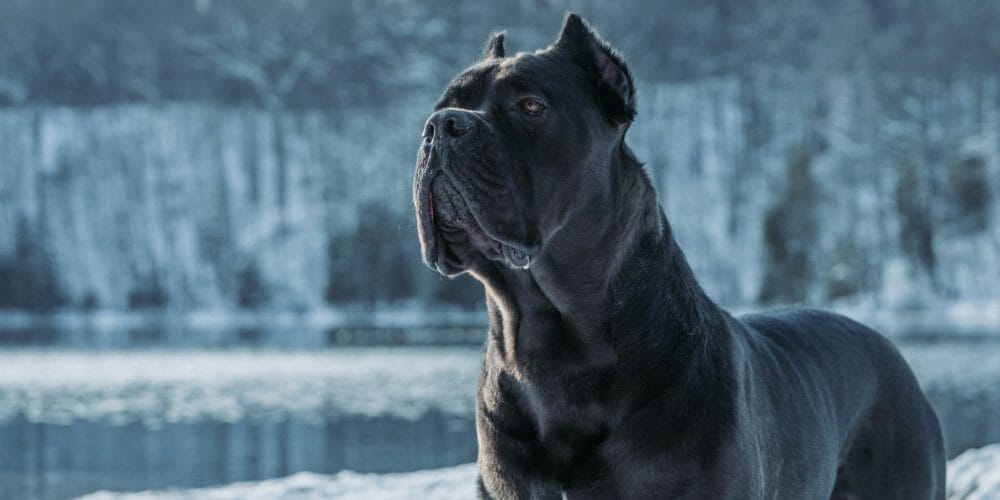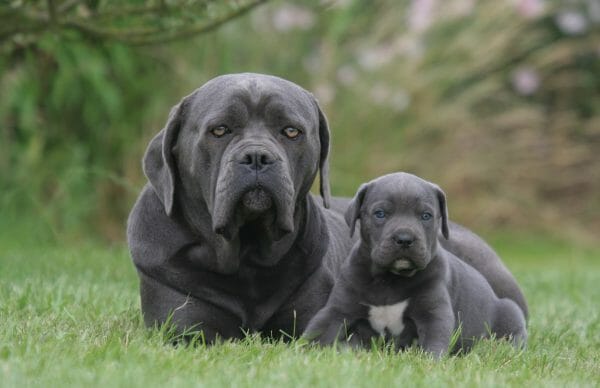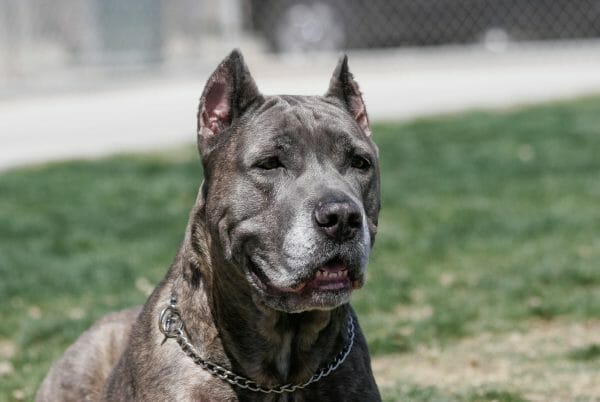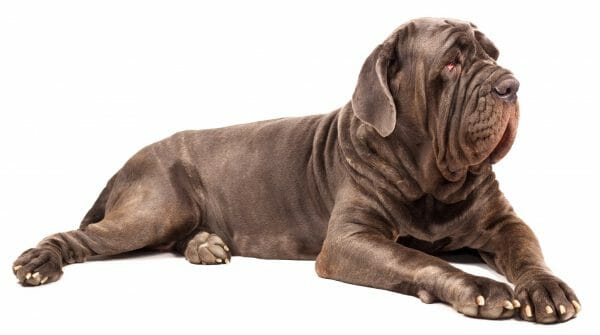Cane Corso

Cane Corso Italian Mastiff
What is a Cane Corso?
Originally bred in Italy during the Middle Ages, the Cane Corso is a breed of dog that is known to be powerful, strong, and dominating in its presence. The Mastiff Cane Corso was originally bred to guard property and hunt big game. While it has been used in years past as a large working and herding dog, it also functions well as a loving, dedicated family dog.
 Standing at an average height between 25 to 28 inches tall, depending on the sex, this breed is a robust, athletic dog with a powerful presence. Per the question almost every dog owner wants to know of “how big do they get?” the answer is, quite big. The biggest Cane Corso Italian Mastiff can weigh up to 130 pounds, with most of the weight being muscle mass.
Standing at an average height between 25 to 28 inches tall, depending on the sex, this breed is a robust, athletic dog with a powerful presence. Per the question almost every dog owner wants to know of “how big do they get?” the answer is, quite big. The biggest Cane Corso Italian Mastiff can weigh up to 130 pounds, with most of the weight being muscle mass.
This breed possesses a life expectancy of around 12 years. This can depend considerably on how well these dogs are kept in shape, given the fact this breed needs daily, intensive exercise to function mentally and physically.
Their coat, known for being beautifully short and shiny, can be black, grey, fawn, or brindle (combination of colors). Breeders have even genetically modified the coat color to make a blue Cane Corso, which is much in demand. Although these dogs shed year-round, it is very little. This makes for easy grooming.
Some lesser known breed info is that their ears are usually cropped by breeders to make them stand up. Naturally, this dog is born with ears that are flopped in a forward-facing direction (think beagles or Labrador retrievers).
Personality Type
While their size and height may not intimidate some buyers that are inexperienced with the breed, buyers should be warned that this breed demands attention and a regimented lifestyle. This breed requires lengthy, intense exercises to be kept in good health and to stimulate its innate intelligence.
 This is a dog that requires constant work or activities to occupy the energy it needs to release. Otherwise, if left alone or bored for long periods, it often releases the energy in ways displeasing to the owner, such as chewing up items or digging holes. A Mastiff Cane Corso requires early and frequent socialization.
This is a dog that requires constant work or activities to occupy the energy it needs to release. Otherwise, if left alone or bored for long periods, it often releases the energy in ways displeasing to the owner, such as chewing up items or digging holes. A Mastiff Cane Corso requires early and frequent socialization.
Even though these dogs are fiercely loyal to the family they belong to and can be surprisingly affectionate, owners should be aware that this breed can be assertive, forceful, and dominating if they are not trained or raised properly.
If raised well, this breed is both quiet and sweet while also being exclusively protective and strictly obedient to its family. Because of the unique Cane Corso temperament, socialization is not a strong suit for the breed and dog parks should mostly be avoided because of this.
All in all, this dog breed can be a wonderful, quietly confident companion that is more than eager to please its owner and family.
Care
In terms of grooming and brushing, the Cane Corso Italian Mastiff dog breed is on the low maintenance end of the spectrum. Although this short-haired breed does shed throughout the year, frequent brushing with a rubber mitt or brush can keep the coat shiny and clean. The nails should be kept short to avoid snagging or scratching.
 This breed requires about 4 to 5 cups of premium dry food per day. It is recommended that this be split up into a meal twice per day in order to avoid bloat or stomach issues. However, the food amount needed depends on the dog’s specific weight, age, and activity level. Treats can be used as small rewards, but too many may result in the dog becoming overweight.
This breed requires about 4 to 5 cups of premium dry food per day. It is recommended that this be split up into a meal twice per day in order to avoid bloat or stomach issues. However, the food amount needed depends on the dog’s specific weight, age, and activity level. Treats can be used as small rewards, but too many may result in the dog becoming overweight.
As mentioned already, one of the most crucial aspects of care that this type of breed needs is through exercise and work or play. Exercise equivalent to a 1-mile fast-paced walk or run should be allowed for daily in adult Cane Corso Mastiffs.
Given that they are keenly intelligent and observant dogs, a good tip would be to teach them tricks and give them small jobs to do to keep up their mental acuity.
As a puppy, this breed of dog should be put through proper training having as far as socialization and obedience skills. If they are sufficiently trained, they should grow up to be well-mannered, mild adults despite their dominating appearance. If no training is administered, there is potential for this breed to be bossy and forceful.
Common Health Problems
Due to its hefty, stout build, this breed is prone to health problems that are specific to large dog breeds. Dogs that are increasingly active throughout life tend to face problems in their joints and bones as old age sets in.
 Hip dysplasia is a condition whereby the hip bone does not fit properly with the joint. This is normally inherited but can also be brought on by an injury. This condition greatly inhibits activity and can often cause limping and weight gain. Degenerative join disease is also a commonly diagnosed problem in larger dogs.
Hip dysplasia is a condition whereby the hip bone does not fit properly with the joint. This is normally inherited but can also be brought on by an injury. This condition greatly inhibits activity and can often cause limping and weight gain. Degenerative join disease is also a commonly diagnosed problem in larger dogs.
Additionally, this breed is especially susceptible to conditions involving the eyes, such as glandular hypertrophy (“cherry eye”), entropion, and ectropion. In a Cane Corso, watery eyes often are a main side effect of entropion, which is when the eyelids begin to go inward. Conversely, with ectropion, the eyelids tend to sag outward, which can result in a thick accumulation of eye discharge.
Overall, this breed is one that is healthy and active. However, special care should be taken to preserve its health through frequent exercise and attention to potential health problems as the dog ages. As with all dogs, core vaccinations (such as those for rabies and parvo) should be provided. In addition, regular preventative medications for fleas, ticks, and heartworm should be given.
If a dog is fed too much, especially in old age, this can trigger bloat, which can turn into an urgent medical emergency. Care should be taken in determining proper food amounts as the dog grows older.
It is recommended that preemptive measures, such as health evaluations of the heart, hip, and elbows, be made early in the dog’s life. This is done to determine if any preexisting conditions are present or if the dog is genetically more prone to a specific health condition that could appear later in life.
Learn more about other large dog breeds, such as the Newfoundland, on the GoodPooch breeds page.



